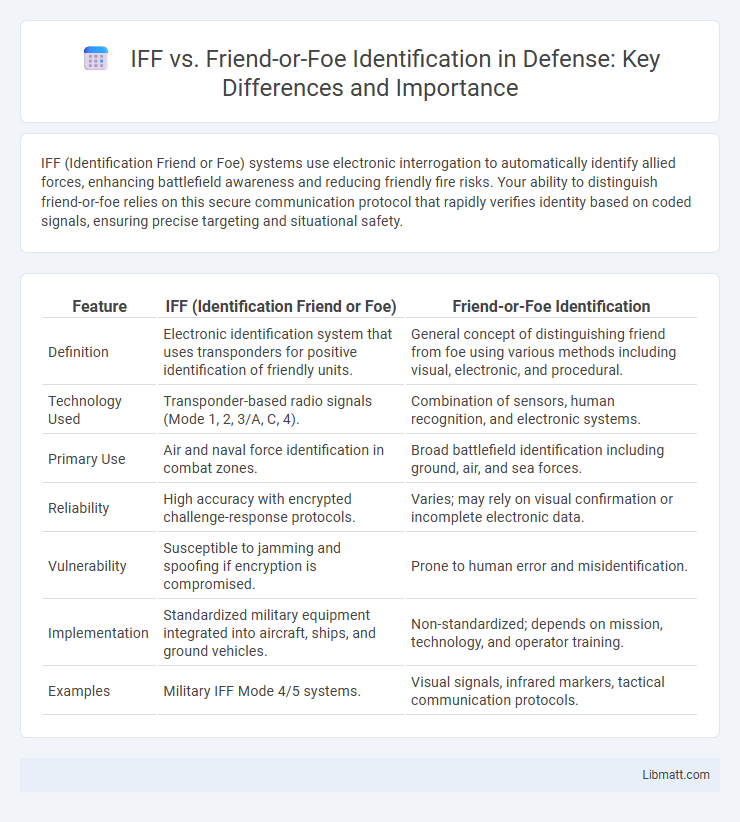IFF (Identification Friend or Foe) systems use electronic interrogation to automatically identify allied forces, enhancing battlefield awareness and reducing friendly fire risks. Your ability to distinguish friend-or-foe relies on this secure communication protocol that rapidly verifies identity based on coded signals, ensuring precise targeting and situational safety.
Table of Comparison
| Feature | IFF (Identification Friend or Foe) | Friend-or-Foe Identification |
|---|---|---|
| Definition | Electronic identification system that uses transponders for positive identification of friendly units. | General concept of distinguishing friend from foe using various methods including visual, electronic, and procedural. |
| Technology Used | Transponder-based radio signals (Mode 1, 2, 3/A, C, 4). | Combination of sensors, human recognition, and electronic systems. |
| Primary Use | Air and naval force identification in combat zones. | Broad battlefield identification including ground, air, and sea forces. |
| Reliability | High accuracy with encrypted challenge-response protocols. | Varies; may rely on visual confirmation or incomplete electronic data. |
| Vulnerability | Susceptible to jamming and spoofing if encryption is compromised. | Prone to human error and misidentification. |
| Implementation | Standardized military equipment integrated into aircraft, ships, and ground vehicles. | Non-standardized; depends on mission, technology, and operator training. |
| Examples | Military IFF Mode 4/5 systems. | Visual signals, infrared markers, tactical communication protocols. |
Understanding IFF: Definition and Purpose
Identification Friend or Foe (IFF) is a secure communication system used primarily in military and aviation contexts to distinguish allied units from potential threats. The system employs transponders that respond to interrogation signals with coded identification data, enabling rapid and reliable classification of units in complex environments. This technology enhances situational awareness, reduces the risk of friendly fire incidents, and improves operational coordination.
Historical Evolution of Friend-or-Foe Identification
The historical evolution of friend-or-foe identification, commonly known as IFF, traces back to World War I when pulse-coded signals began to differentiate allied aircraft from enemies. Early systems utilized simple Morse code transmissions, evolving through World War II with the advent of radar-based transponders that enhanced real-time identification accuracy. Your understanding of modern IFF systems benefits from this legacy of progressive technological advancements aimed at reducing friendly fire and improving battlefield awareness.
Core Technologies Behind IFF Systems
IFF systems rely on transponders, radar technology, and encrypted communication protocols to accurately identify friendly aircraft and vehicles. These systems use interrogation signals and coded responses to distinguish allies from potential threats in real-time. Your understanding of IFF technology enhances situational awareness and operational security during complex missions.
Differences Between IFF and Traditional Friend-or-Foe Methods
IFF (Identification Friend or Foe) systems utilize encrypted electronic signals to automatically identify allied units, offering rapid and reliable recognition in combat scenarios. Traditional friend-or-foe methods rely on visual identification, manual signals, or predefined behaviors, which can lead to slower response times and higher risk of misidentification. The integration of cryptographic authentication in IFF provides enhanced security and reduces friendly fire incidents compared to conventional methods.
IFF Applications in Military and Civil Aviation
IFF systems play a critical role in military operations by rapidly distinguishing allied aircraft and vehicles from potential threats, enhancing battlefield awareness and reducing the risk of friendly fire. In civil aviation, IFF technology supports air traffic control by identifying registered aircraft, ensuring safe navigation and preventing collisions in crowded airspace. Your reliance on IFF for accurate identification strengthens coordination and security across both military and civilian flight operations.
Security Challenges with IFF and Friend-or-Foe Systems
Security challenges with Identification Friend or Foe (IFF) systems include vulnerabilities to spoofing, jamming, and cyber-attacks that can compromise the authenticity of signals, leading to potential misidentification and hostile engagements. Friend-or-foe identification protocols rely heavily on secure encryption and frequency hopping, but adversaries continuously develop sophisticated electronic warfare techniques to intercept or mimic signals. Enhancing the resilience of Your IFF system requires integrating robust cryptographic methods and real-time anomaly detection to mitigate risks posed by evolving electronic threats.
Advances in Electronic Identification Technologies
Electronic Identification Technologies have significantly enhanced IFF (Identification Friend or Foe) systems by integrating advanced radar, encrypted communication protocols, and machine learning algorithms for real-time threat assessment. Modern IFF systems utilize biometric data, multifactor authentication, and secure transponders to reduce false identifications and improve battlefield situational awareness. These advancements contribute to greater operational security and efficiency in both military and civilian airspace management.
Case Studies: IFF in Modern Combat Scenarios
In modern combat scenarios, IFF (Identification Friend or Foe) systems have proven crucial in preventing friendly fire incidents and enhancing mission efficiency by rapidly distinguishing allied units from adversaries. Case studies, such as those in recent coalition operations, demonstrate how advanced IFF technology integrates with real-time data networks to provide accurate identification even in contested electronic environments. Your reliance on these systems ensures better situational awareness and reduces the risk of misidentification under complex battlefield conditions.
Future Trends in Friend-or-Foe Identification
Future trends in friend-or-foe identification emphasize the integration of artificial intelligence and machine learning algorithms to enhance real-time threat detection accuracy. Advances in sensor fusion technology will enable the simultaneous processing of radar, infrared, and electronic signals, improving identification reliability in complex combat environments. The development of secure, interoperable communication protocols will facilitate seamless data sharing across allied platforms, reducing incidents of misidentification and friendly fire.
Ethical and Legal Implications of IFF Deployment
Identification Friend or Foe (IFF) systems raise significant ethical and legal concerns due to their reliance on automated decision-making in combat environments. Misidentification risks causing unintended civilian casualties and violating international humanitarian law principles, particularly proportionality and distinction. Legal frameworks demand rigorous accuracy standards and accountability mechanisms to ensure compliance with human rights and wartime conduct regulations.
IFF vs friend-or-foe identification Infographic

 libmatt.com
libmatt.com